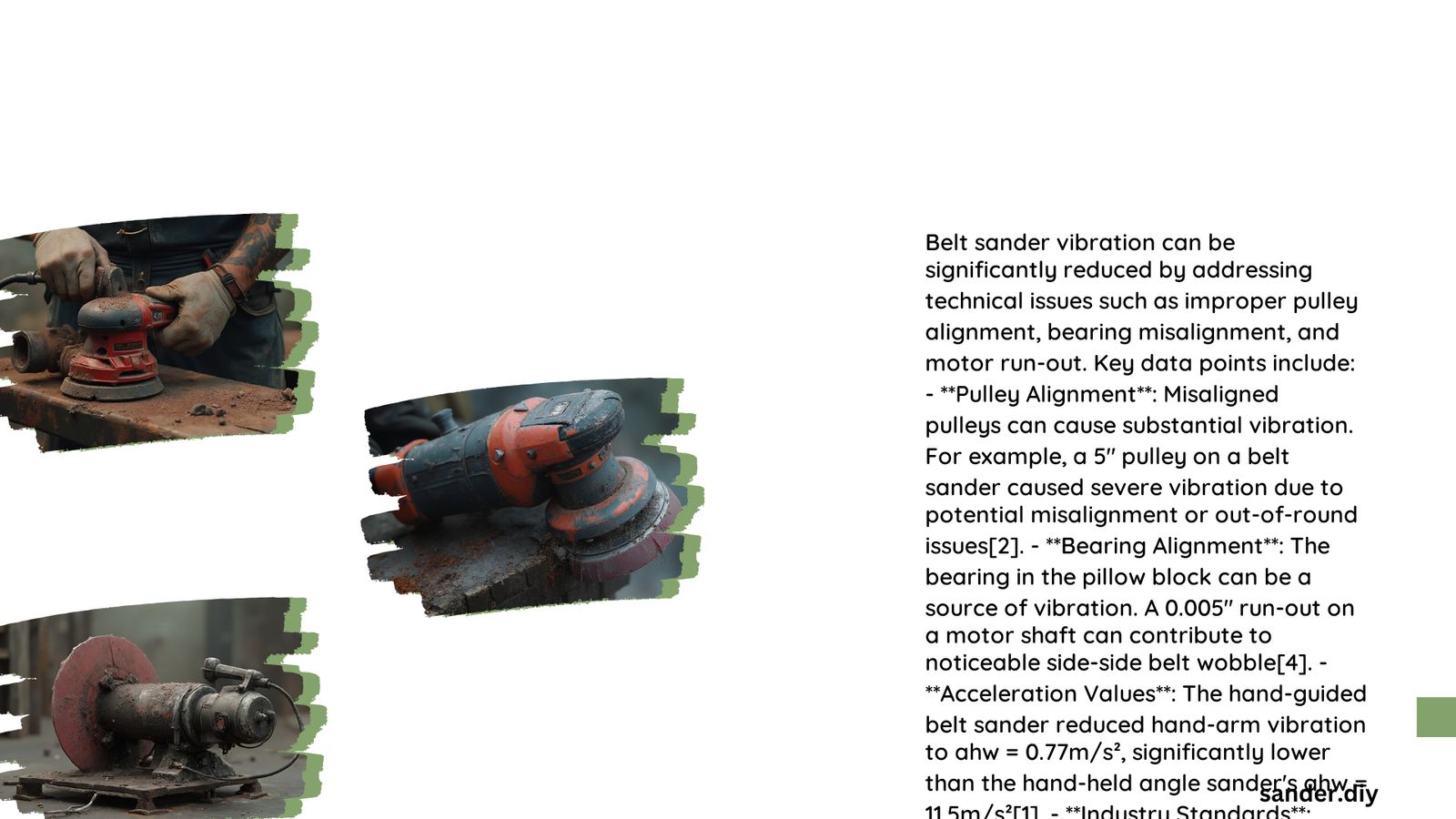Belt sander vibration is a complex phenomenon that affects tool performance and user comfort. These power tools exhibit a varied vibration spectrum, with frequencies typically above 20 Hz and multiple peaks across different bands. Understanding and managing belt sander vibration is crucial for optimal performance, user safety, and tool longevity. This article explores the causes, effects, and solutions related to belt sander vibration, providing insights for both professionals and DIY enthusiasts.
What Causes Belt Sander Vibration?
Belt sanders experience vibration due to several factors:
- Motor operation
- Belt movement
- Uneven surfaces
- Worn components
- Improper belt tension
The interaction of these elements creates a complex vibration profile that can affect both the tool’s performance and the user’s experience.
How Does Vibration Frequency Vary in Belt Sanders?

Belt sanders exhibit a unique vibration profile compared to other power tools:
- Frequency range: Generally above 20 Hz
- Multiple peaks: Across various frequency bands
- Broader spectrum: No single dominant frequency
Unlike orbital sanders with a specific rotation-related frequency, belt sanders show a more diverse vibration pattern. This complexity stems from the continuous belt movement and the interaction between the sander and the work surface.
What Are the Effects of Belt Sander Vibration on Users?
Prolonged exposure to belt sander vibration can lead to several health issues:
- Hand-Arm Vibration Syndrome (HAVS)
- Carpal Tunnel Syndrome
- Reduced grip strength
- Numbness and tingling in fingers
- Decreased sensitivity to temperature and touch
These effects underscore the importance of managing and mitigating belt sander vibration for user safety and comfort.
How Can Belt Sander Vibration Be Measured?
Accurate measurement of belt sander vibration involves specialized tools and techniques:
- Accelerometers: Mounted on the handle near the hand position
- Frequency analyzers: Such as the Norsonic 830
- Data collection software: For recording and analyzing vibration data
Measurements should adhere to ISO 5349 standards, considering factors like sanding sheet type, material being worked on, and operator technique.
What Vibration Dampening Techniques Are Used in Belt Sanders?
Manufacturers employ various methods to reduce belt sander vibration:
- Ergonomic handle design
- Vibration-absorbing materials (e.g., rubber, foam)
- Counterbalance weights
- Improved belt alignment systems
These techniques aim to minimize vibration transmission to the user, enhancing comfort and reducing the risk of vibration-related health issues.
How Does Belt Tension Affect Vibration?
Proper belt tension is crucial for minimizing vibration in belt sanders:
| Belt Tension | Vibration Level | Performance |
|---|---|---|
| Too Loose | High | Poor |
| Optimal | Low | Excellent |
| Too Tight | Moderate | Reduced |
Maintaining the correct belt tension ensures smooth operation and reduces unnecessary vibration, contributing to better sanding results and user comfort.
What Role Does Maintenance Play in Reducing Belt Sander Vibration?
Regular maintenance is key to managing belt sander vibration:
- Clean and inspect the tool regularly
- Replace worn belts and components
- Check and adjust belt alignment
- Lubricate moving parts as recommended
- Ensure proper belt tension
Proper maintenance not only reduces vibration but also extends the tool’s lifespan and maintains its performance.
How Can Users Protect Themselves from Belt Sander Vibration?
Users can take several steps to minimize the impact of belt sander vibration:
- Use anti-vibration gloves
- Take regular breaks during extended use
- Maintain a proper grip on the tool
- Use the sander at the recommended speed
- Ensure the workpiece is properly secured
These practices help reduce vibration exposure and mitigate potential health risks associated with prolonged use of belt sanders.
What Innovations Are Addressing Belt Sander Vibration?
Recent innovations in belt sander design focus on vibration reduction:
- Advanced motor balancing techniques
- Improved belt tracking systems
- Integration of electronic vibration control
- Development of new dampening materials
- Ergonomic handle designs with enhanced vibration isolation
These advancements aim to provide a smoother, more comfortable sanding experience while maintaining high performance.
How Does Belt Sander Vibration Compare to Other Power Tools?
Belt sanders generally exhibit different vibration characteristics compared to other power tools:
- Orbital Sanders: More focused frequency range, often lower overall vibration
- Angle Grinders: Higher vibration levels, especially at higher speeds
- Jigsaws: Varied vibration profile depending on blade type and cutting material
- Drills: Generally lower vibration levels, except during high-torque operations
Understanding these differences helps users select the appropriate tool for their needs and take necessary precautions.
What Are the Industry Standards for Belt Sander Vibration?
Several standards govern belt sander vibration:
- ISO 5349: Measurement and evaluation of human exposure to hand-transmitted vibration
- EU Directive 2002/44/EC: Minimum health and safety requirements regarding worker exposure to vibration
- ANSI S2.70: Guide for the measurement and evaluation of human exposure to vibration transmitted to the hand
These standards provide guidelines for manufacturers and employers to ensure safe tool operation and user protection.
By understanding the causes, effects, and solutions related to belt sander vibration, users can make informed decisions about tool selection, usage, and maintenance. This knowledge contributes to safer, more efficient sanding operations and helps preserve user health in both professional and DIY settings.
